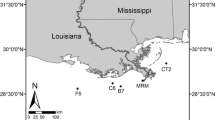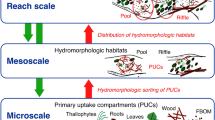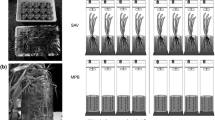Abstract
The distribution of nitrogen-transforming processes, and factors controlling their rates, were determined within the hyporheic zone of a lowland stream draining agricultural land. In the field, physicochemical parameters were measured along a 10 m-long hyporheic flow line between downwelling and upwelling zones. Sediment cores were retrieved from the stream bed surface, and from 20, 40 and 60 cm deep in each zone, and in the laboratory, water from the corresponding depth was percolated through each core at the natural flow rate. Concentrations of nitrogen species and oxygen were measured before and after flow through each core. Denitrification was measured using a 15N-nitrate tracer. Shallow and downwelling zone samples were clearly distinct from deeper and upwelling zone samples in terms of physicochemical conditions, microbial processes and factors controlling nitrogen processing. Denitrification was highest in surface and downwelling zone cores, despite high oxygen levels, probably due to high pore-water nitrate concentrations in these cores and isolation of the denitrifying bacteria from oxygen in the bulk water by the hyporheic biofilms. Denitrification was limited by oxygen inhibition in the downwelling group, and by nitrate availability in the upwelling group. Strong evidence indicated that dissimilatory nitrate reduction to ammonium, occurred in almost all cores, and outcompeted denitrification for nitrate. In contrast, nitrification was undetectable in all but two cores, probably because of intense competition for oxygen. Field patterns and lab experiments indicated that the hyporheic zone at this moderately N-rich site is a strong sink for nitrate, fitting current theories that predict where hyporheic zones are nitrate sinks or nitrate sources.
Similar content being viewed by others
References
Baker M.A., Dahm C.N. and Valett H.M. 2000. Anoxia, anaerobic metabolism, and biogeochemistry of the stream-water-groundwater interface. In: Jones J.B. and Mulholland P.J. (eds) Streams and Ground Waters. Academic Press, Boston, pp. 259–283.
Bishop J.E. and Hynes H.B.N. 1969. Upstream movements of the benthic invertebrates in the Speed River, Ontario. J. Fish. Res. Board Canada 26: 279–298.
Chestnut T.J. and McDowell W.H. 2000. C and N dynamics in the riparian and hyporheic zones of a tropical stream, Luquillo Mountains, Puerto Rico. J. N. Am. Benthol. Soc. 19: 199–214.
Dent C.L., Schade J.D., Grimm N.B. and Fisher S.G. 2000. Subsurface influences on surface biology. In: Jones J.B. and Mulholland P.J. (eds) Streams and Ground Waters. Academic Press, Boston, pp. 381–402.
Duff J.H. and Triska F.J. 1990. Denitrification in sediments from the hyporheic zone adjacent to a small forested stream. Can. J. Fish. Aquat. Sci. 47: 1140–1147.
Duff J.H. and Triska F.J. 2000. Nitrogen biogeochemistry and surface-subsurface exchange in streams. In: Jones J.B. and Mulholland P.J. (eds) Streams and Ground Waters. Academic Press, Boston, pp. 197–220.
Fellows C.S., Valett H.M. and Dahm C.N. 2001. Whole-stream metabolism in two montane streams: contribution of the hyporheic zone. Limnol. Oceanogr. 46: 523–531.
Findlay S. 1995. Importance of surface–subsurface exchange in stream ecosystems: The hyporheic zone. Limnol. Oceanogr. 40: 159–164.
Findlay S. and Sobczak W.V. 2000. Microbial communities in hyporheic sediments. In: Jones J.B. and Mulholland P.J. (eds) Streams and Ground Waters. Academic Press, Boston, pp. 284–306.
Fraser B.F. and Williams D.D. 1998. Seasonal boundary dynamics of a groundwater/surface-water ecotone. Ecology 79: 2019–2031.
Fraser B.F., Williams D.D. and Howard K.W.F. 1996. Monitoring biotic and abiotic processes across the hyporheic/groundwater interface. Hydrogeol. J. 4: 36–50.
Fuss C.L. and Smock L.A. 1996. Spatial and temporal distribution of microbial respiration rates in a blackwater stream. Freshwat. Biol. 36: 339–349.
Gibert J., Dole-Olivier M.-J., Marmonier P. and Vervier P. 1990. Surface water–groundwater ecotones. In: Naiman R.J. and Decamps H. (eds) The Ecology and Management of Aquatic–Terrestrial Ecotones. UNESCO and the Parthenon Publishing Group, Park Ridge, New Jersey, pp. 199–225.
Halda-Alija L., Hendricks S.P. and Johnston T.C. 2001. Spatial and temporal variations of Enterobacter genotypes in sediments and the underlying hyporheic zone of an agricultural stream. Microb. Ecol. 42: 286–294.
Hill A.R., Labadia C.F. and Sanmugadas K. 1998. Hyporheic zone hydrology and nitrogen dynamics in relation to the streambed topography of a N-rich stream. Biogeochemistry 42: 285–310.
Hinkle S.R., Duff J.H., Triska F.J., Laenen A., Gates E.B., Bencala K.E., Wentz D.A. and Silva S.R. 2001. Linking hyporheic flow and nitrogen cycling near the Willamette River – a large river in Oregon, USA. J. Hydrol. 244: 157–180.
Holmes R.M., Jones J.B., Fisher S.G. and Grimm N.B. 1996. Denitrification in a nitrogen-limited stream ecosystem. Biogeochemistry 33: 125–146.
Jones J.B. 1995. Factors controlling hyporheic respiration in a desert stream. Freshwat. Biol. 34: 91–99.
Jones J.B. and Holmes R.M. 1996. Surface–subsurface interactions in stream ecosystems. Trends Ecol. Evol. 11: 239–242.
Jones J.B., Fisher S.G. and Grimm N.B. 1995. Nitrification in the hyporheic zone of a desert stream ecosystem. J. N. Am. Benthol. Soc. 14: 249–258.
Kelso B.H.L., Smith R.V. and Laughlin R.J. 1999. Effects of carbon substrates on nitrite accumulation in freshwater sediments. Appl. Environ. Microbiol. 65: 61–66.
Malhi S.S. and Nyborg M. 1983. Release of mineral N from soils: influence of inhibitors of nitrification. Soil Biol. Biochem. 15: 581–585.
McMahon P.B., Tindall J.A., Collins J.A. and Lull K.J. 1995. Hydrologic and geochemical effects on oxygen uptake in bottom sediments of an effluent-dominated river. Water Resour. Res. 31: 2561–2569.
Morrice J.A., Valett H.M., Dahm C.N. and Campana M.E. 1997. Alluvial characteristics, groundwater– surface water exchange and hydrological retention in headwater streams. Hydrol. Proc. 11: 253–267.
Naegeli M.W. and Uehlinger U. 1997. Contribution of the hyporheic zone to ecosystem metabolism in a prealpine gravel-bed river. J. N. Am. Benthol. Soc. 16: 794–804.
Naegeli M.W., Hartmann U., Meyer E.I. and Uehlinger U. 1995. POM-dynamics and community respiration in the sediments of a floodprone prealpine river (Necker, Switzerland). Arch. Hydrobiol. 133: 339–347.
Nakajima T. 1979. Denitrification by the sessile microbial community of a polluted river. Hydrobiologia 66: 57–64.
Nelson D.W. and Sommers L.E. 1996. Total carbon, organic carbon and organic matter. In: Methods of Soil Analysis. Part 3: Chemical Methods. Soil Sci. Soc. Am. and Am. Soc. Agronomy, Madison, WI, pp. 961–1010.
Nielsen L.P. 1992. Denitrification in sediment determined from nitrogen isotope pairing. FEMS Microbiol. Ecol. 86: 357–362.
Pinay G., Haycock N.E., Ruffinoni C. and Holmes R.M. 1994. The role of denitrification in nitrogen removal in river corridors. In: Mitsch W.J. (ed) Global Wetlands: Old World and New. Elsevier, Amsterdam, pp. 1-7116.
Pusch M.H.E. 1987. Die Besiedlung des hyporheischen Interstitals in einem Schwarzwaldbach. Diploma thesis, University of Freiberg.
Pusch M. 1996. The metabolism of organic matter in the hyporheic zone of a mountain stream, and its spatial distribution. Hydrobiologia 323: 107–118.
Riemer M. and Harremoës P. 1978. Multi-component diffusion in denitrifying biofilms. Progr. Water Tech. 10: 149–165.
Sabater S., Guasch H., Romaní A. and Muñoz I. 2002. The effect of biological factors on the efficiency of river biofilms in improving water quality. Hydrobiologia 469: 149–156.
Schramm A., Larsen L.H., Revsbech N.P., Ramsing N.B., Amann R. and Schleifer K.H. 1996. Structure and function of a nitrifying biofilm as determined by in situ hybridisation and the use of microelectrodes. Appl. Environ. Microbiol. 62: 4641–4647.
Stanley E.H. and Jones J.B. 2000. Surface–subsurface interactions: past, present, future. In: Jones J.B. and Mulholland P.J. (eds) Streams and Ground Waters. Academic Press, Boston, pp. 405–417.
Stocker Z.S.J. and Williams D.D. 1972. A freezing core method for describing the vertical distribution of sediments in a streambed. Limnol. Oceanogr. 17: 136–138.
Storey R.G. 2001. Spatial and temporal variability in a hyporheic zone: a hierarchy of controls from water flows to meiofauna. PhD Thesis, University of Toronto, 230 pp.
Storey R.G., Howard K.W.F. and Williams D.D. 2003. Factors controlling riffle-scale hyporheic exchange flows and their seasonal changes in a gaining stream: a three-dimensional groundwater flow model. Water Resour. Res. 39(2): Art. No. 1034.
Tiedje J.M. 1988. Ecology of denitrification and dissimilatory nitrate reduction to ammonium. In: Zehnder A.J.B. (ed) Biology of Anaerobic Microorganisms. JohnWiley &;; Sons, Toronto, pp. 179–244
Triska F.J., Duff J.H. and Avanzino R.J. 1990. Influence of exchange flow between the channel and hyporheic zone on NO -3 production in a small mountain stream. Can. J. Fish. Aquat. Sci. 11: 2099–2111.
Triska F.J., Duff J.H. and Avanzino R.J. 1993. The role of water exchange between a stream channel and its hyporheic zone in nitrogen cycling at the terrestrial–aquatic interface. Hydrobiologia 251: 167–184.
Valett H.M., Morrice J.A., Dahm C.N. and Campana M.E. 1996. Parent lithology, surface–groundwater exchange, and nitrate retention in headwater streams. Limnol. Oceanogr. 41: 333–345.
Vannelli T. and Hooper A.B. 1992. Oxidation of nitrapyrin to 6-chloropicolinic acid by the ammonia-oxidising bacterium Nitrosomonas europaea. Appl. Environ. Microbiol. 58: 2321–2326.
Vannelli T. and Hooper A.B. 1993. Reductive dehalogenation of the trichloromethyl group of nitrapyrin by the ammonia-oxidizing bacterium Nitrosomonas europaea. Appl. Environ. Microbiol. 59: 3597–3601.
Ventullo R.M. and Rowe J.J. 1982. Denitrification potential of epilithic communities in a lotic environment. Current Microbiol. 7: 29–33.
Wondzell S.M. and Swanson F.J. 1996. Seasonal and storm dynamics of the hyporheic zone of a 4th-order mountain stream. II: nitrogen cycling. J. N. Am. Benthol. Soc. 15: 20–34.
Rights and permissions
About this article
Cite this article
Storey, R.G., Williams, D.D. & Fulthorpe, R.R. Nitrogen processing in the hyporheic zone of a pastoral stream. Biogeochemistry 69, 285–313 (2004). https://doi.org/10.1023/B:BIOG.0000031049.95805.ec
Issue Date:
DOI: https://doi.org/10.1023/B:BIOG.0000031049.95805.ec




